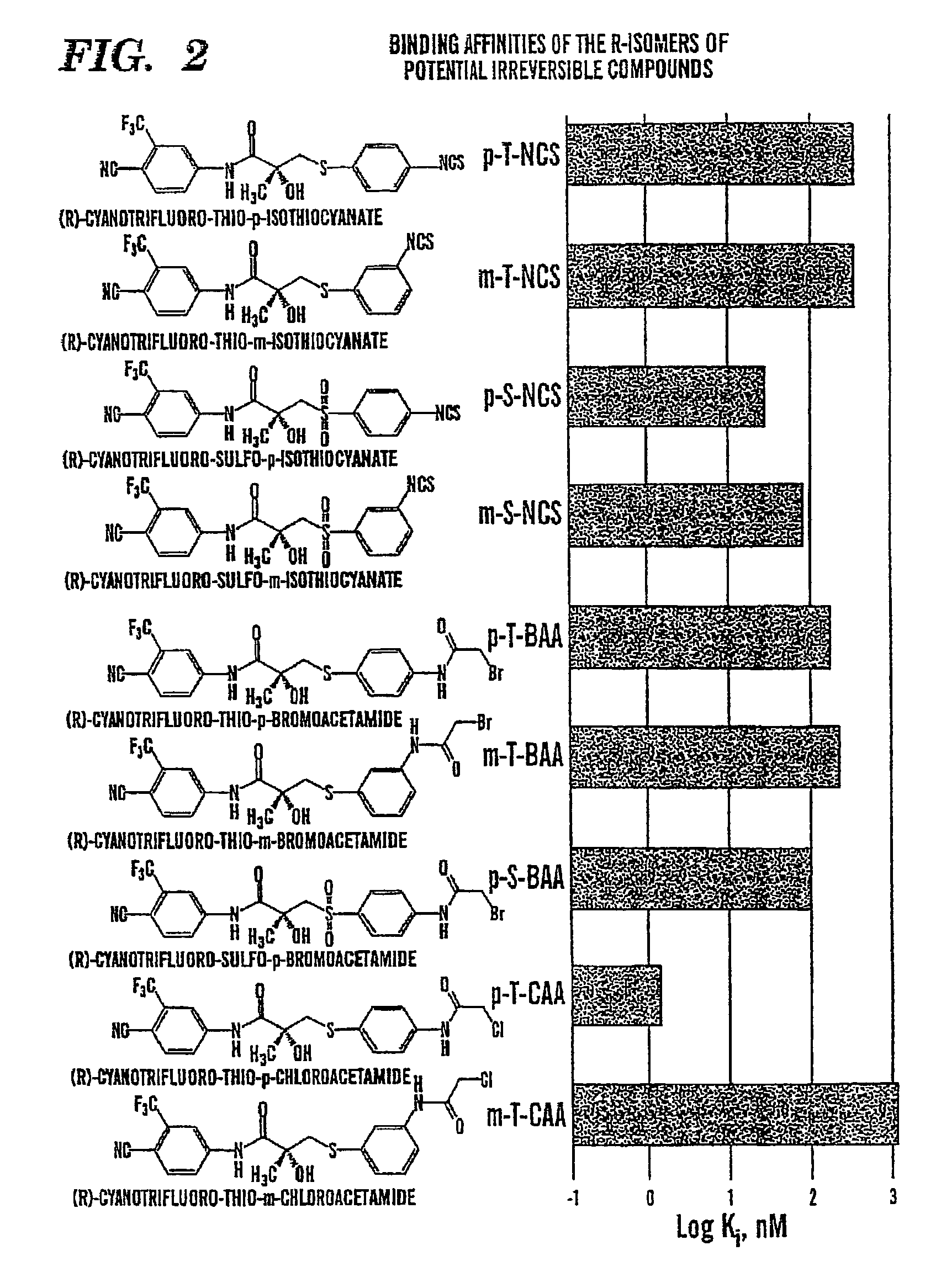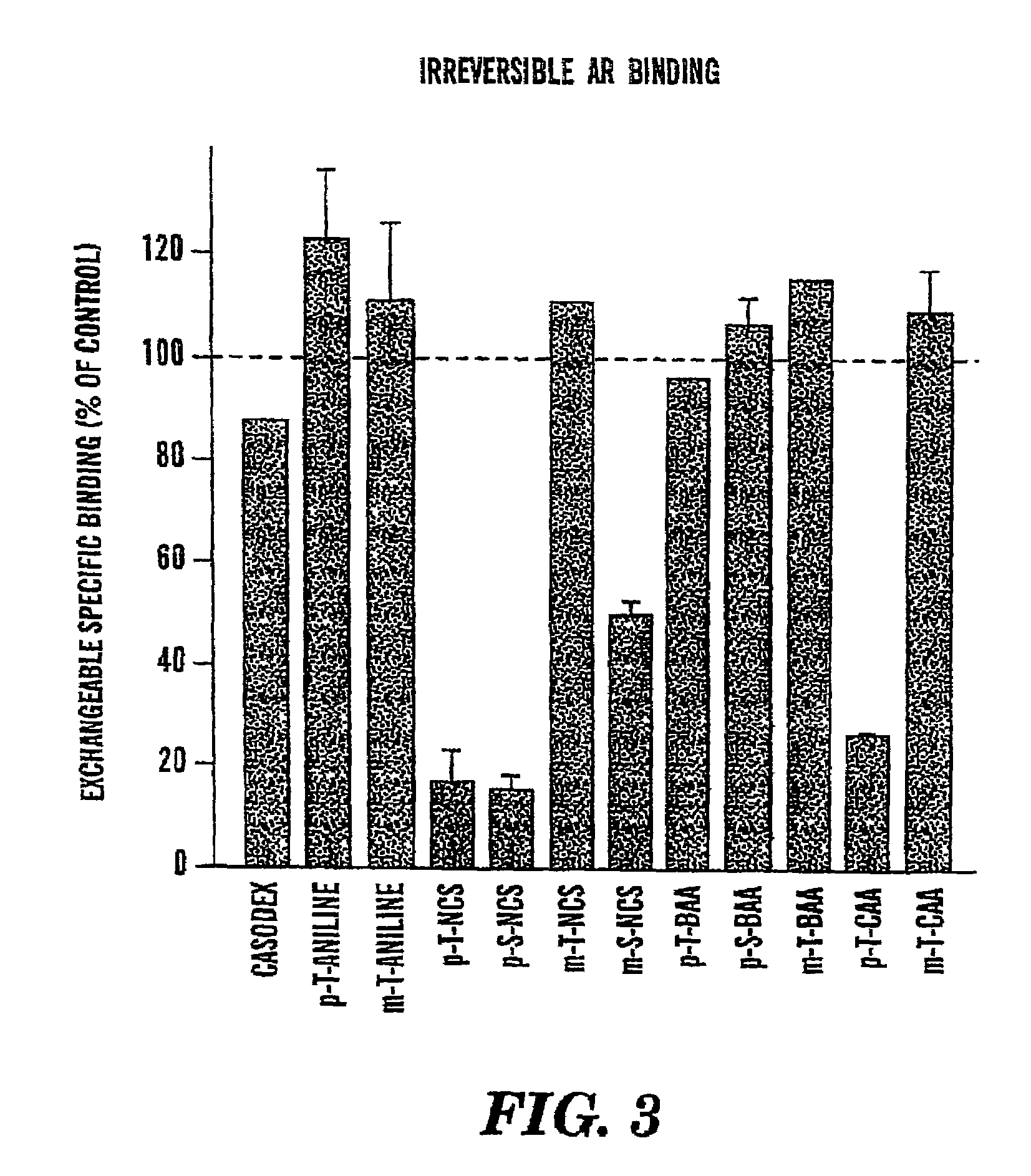Irreversible non-steroidal antagonist compound and its use in the treatment of prostate cancer
a non-steroidal anti-cancer, irreversible technology, applied in the direction of nitrile/isonitrile active ingredients, biocide, organic chemistry, etc., can solve the problems of cytotoxic chemotherapy being largely ineffective in treating prostate cancer, affecting the survival rate of patients, and most cancers had spread beyond the bounds of operation,
- Summary
- Abstract
- Description
- Claims
- Application Information
AI Technical Summary
Benefits of technology
Problems solved by technology
Method used
Image
Examples
example 1
[0091](R)- and (S)-enantiomeric analogs of Casodex bearing affinity labels such as isothiocyanates, chloroacetamides, bromoacetamides, or azides were synthesized. The synthesized compounds according to the formula:
[0092]
are shown in Table 3 below:
[0093]
TABLE 3SubstituentsR-isomersS-isomerRXNo.Ki, nMNo.Ki, nM4-NH2SR-170S-18303-NH2SR-240S-223004-NCSSR-3400S-3≈400O4-NCSSO2R-4304-N3SR-511.54-NHCOCH2ClSR-61.64-NHCOCH2BrSR-72004-NHCOCH2BrSO2R-81003-NCSSR-9380S-927003-NCSSO2R-10903-NHCOCH2ClSR-1111003-NHCOCH2BrSR-12250
[0094]Analogs bearing an amine affinity labels were produced by the following procedure. (S)- or (R)-proline was used as the chiral matrix for syntheses of (R)- and (S)-anilines (R-1, R-2, S-1, and S-2 in Table 3) in Scheme 1 (shown below) as the starting materials for preparation of the affinity labels. This scheme is similar to the general synthetic route reported by Tucker and Chesterson for (S)-Casodex, in Tucker et al., “Resolution of the Non-steroidal Antiandrogen 4′-Cy...
example 2
[0101]Receptor binding studies for the compounds shown in Table 3 were conducted as follows.
[0102]Mibolerone (MIB) is a synthetic androgen with high affinity and high specificity for the AR.
[0103]Competitive displacement of 3H-MIB from AR binding sites by our compound was assessed as follows:
[0104]1. AR were isolated from rat ventral prostate tissue by differential centrifugation.
[0105]2. Samples of the following composition listed in Table 4 were incubated at 4° C. for 18 hours:
[0106]
TABLE 43H-MIB 1 nMTriamcinolone 1 μMTRIS buffer 10 mMAR protein14.5 mg protein / ml, final concentrationCasodex analog10−6 μM to 10 μM
[0107]Non-specific binding was determined by including MIB (1 μM) in the above incubate.
[0108]3. Bound 3H-MIB was separated by addition of a slurry of hydroxyapatite, and extracted from hydroxyapatite with ethanol.
[0109]4. Bound 3H-MIB was counted using liquid scintillation spectrometry.
Percent Specific Binding=(B / B0)×100
[0110]B=specific binding of 3H-MIB i...
example 3
[0128]A series of electrophilic nonsteroidal compounds were designed and synthesized with the ability to irreversibly and permanently bind the AR, and thereby permanently inhibit the ability of testosterone (“T”) and dihydrotestosterone (“DHT”) to bind the androgen receptor. The ability of these compounds was evaluated to: (A) compete for binding to the AR, and (B) to irreversibly bind the AR and permanently inhibit binding by other agents. The experimental methods and results of these studies are summarized below.
[0129]A. Ability of our Compounds to Compete for AR Binding
Methods:
[0130]The ability of the compounds was evaluated to compete with mibolerone (MIB) for rat ventral prostate AR. MIB is a highly specific AR ligand which demonstrates greater affinity and specificity for the AR than DHT, is not metabolized like T and DHT, and is not light-sensitive as is the case for methyltrienolone (R1881), another commonly used AR radioligand. AR isolation was performed as follows. Bilater...
PUM
| Property | Measurement | Unit |
|---|---|---|
| temperature | aaaaa | aaaaa |
| temperature | aaaaa | aaaaa |
| time | aaaaa | aaaaa |
Abstract
Description
Claims
Application Information
 Login to View More
Login to View More - R&D
- Intellectual Property
- Life Sciences
- Materials
- Tech Scout
- Unparalleled Data Quality
- Higher Quality Content
- 60% Fewer Hallucinations
Browse by: Latest US Patents, China's latest patents, Technical Efficacy Thesaurus, Application Domain, Technology Topic, Popular Technical Reports.
© 2025 PatSnap. All rights reserved.Legal|Privacy policy|Modern Slavery Act Transparency Statement|Sitemap|About US| Contact US: help@patsnap.com



